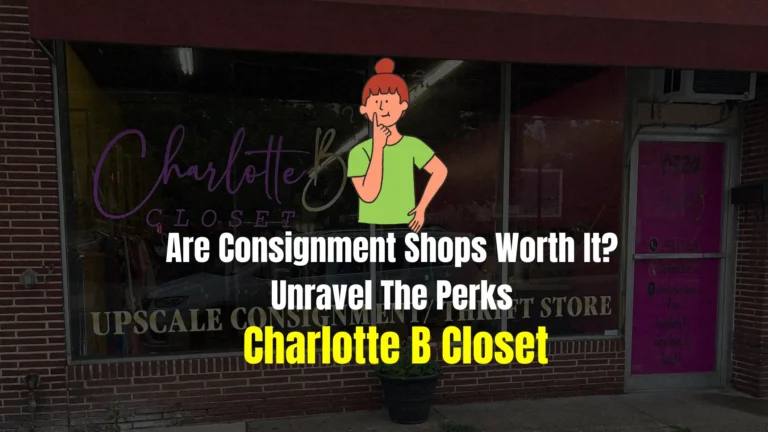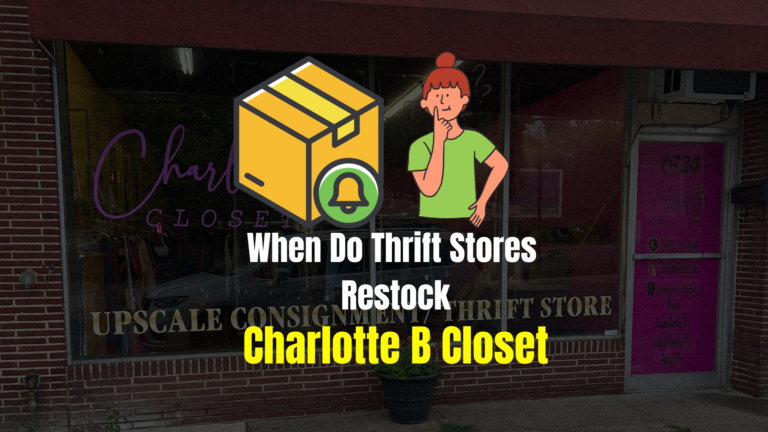How To Spot Antiques At Thrift Stores – Expert Insights
Every thrift store adventurer has faced the challenge of distinguishing a hidden gem from mere old junk.
Unearthing valuable antiques can often feel like searching for a needle in a haystack. So, how to spot antiques at thrift stores?
To effectively spot antiques at thrift stores, one should secure a cart for potential finds, invest time in thorough exploration, identify items with maker’s markings, explore unexpected sections, visualize an item’s potential beyond its current state, and be ready for hands-on investigation.
How to Spot Antiques at Thrift Stores – A Brief Overview
Spotting valuable antiques at thrift stores is a skill akin to decoding a secret language. Begin with equipping yourself with a cart; it’s your best companion. Dedicate ample time, sifting patiently through aisles and racks. An antique’s authenticity often lies in details, like the maker’s markings, so keep a sharp eye out. Don’t be restricted to the obvious spots; sometimes, the most prized items hide in the least expected corners. And remember, the beauty of antiques often lies beneath the surface; see beyond the immediate. Embrace the adventure, even if it means rolling up your sleeves and delving deep into dusty corners. Your next great find might just be a shelf away.
Effective Tricks To Spot Antiques at Thrift Stores
Venturing into thrift stores can be like diving into a treasure trove. With the right strategies and an observant eye, one can unearth unique antiques that have rich histories and potentially high value. Know where to look, and let intuition guide you.
Get a Cart First Thing
Upon entering a thrift store, your initial instinct might be to scan the area quickly to see if anything catches your eye. But before you get started, grab a cart!
Even if you believe you won’t find much, having a cart by your side ensures you have ample space to keep potential treasures.
There’s nothing more regrettable than stumbling upon multiple valuable items and having no place to keep them.
Moreover, a cart allows you to safely place fragile items without the risk of breaking them.
Patience is the Key: Take Your Time
Thrift store shopping is unlike any regular shopping experience. It requires a considerable amount of patience.
Unlike traditional stores, where items are displayed prominently, treasures in thrift stores might be hidden or tucked away.
Take your time to go through each aisle, rack, and shelf. By rushing, you might miss out on a rare antique that’s worth much more than its price tag.
Uncover the Secrets: Always Look for Maker’s Markings
One of the telltale signs of an antique’s authenticity and value is the maker’s mark.
These are often stamps, signatures, labels, or engravings indicating the manufacturer or artisan.
It can be on the bottom of ceramics, the back of artworks, or inside vintage books.
Identifying these marks can not only give insight into the item’s origin but can also significantly increase its worth.
It’s advisable to carry a small magnifying glass to help spot these tiny yet critical details.
Think Outside the Box: Look in Unusual Places
Many assume that antiques will be placed in the ‘special items’ section, but that’s not always the case.
Some of the best finds are often in the most unexpected places. Check behind larger objects, inside furniture drawers, or even among children’s toys.
Thrift stores receive a vast number of items daily, and sometimes treasures are misplaced.
By exploring every nook and cranny, you enhance your chances of finding valuable antiques.
The Power of Imagination: See Beyond
At first glance, an item might appear old, tarnished, or broken. But with a little imagination and vision, you can often see its potential.
An old frame with a torn painting might still have value in its ornate design. A tarnished silver teapot could shine again with a little polish.
Train your eyes to see beyond the surface wear and tear. Sometimes, what lies beneath is a valuable antique waiting for a second chance.
Dive Deep: Be Prepared to Get a Little Dirty
Antique hunting in thrift stores isn’t always a clean job. You might find yourself digging through dusty boxes, rummaging through bins, or examining items stored in basements or attics.
Wear comfortable clothing, perhaps even gloves, and be prepared for some hands-on exploration.
The search can be gritty but remember, diamonds are found in the rough. Your willingness to get a bit dirty might just lead you to your next prized possession.
How Do I Know if an Antique is Valuable?
The world of antiques is alluring, filled with objects that whisper tales from the past. However, not all that glitter is gold. Distinguishing truly valuable antiques requires knowledge of history, craftsmanship, and the current market demand.
Historical Significance
An antique’s value is often tied to its historical significance. Items that have been a part of significant events or periods in history tend to hold more value. This can range from items used in historical events, artworks from renowned periods, or artifacts that shed light on past cultures and civilizations.
Understanding the historical context of an item can provide insights into its potential worth.
For instance, a simple chair may just seem like old furniture, but if it was used by a notable figure or during a pivotal event, its value could be immense.
Rarity and Demand
In the world of antiques, the laws of supply and demand still apply. Items that are rare and in high demand naturally fetch a higher price.
The fewer pieces available in the market, the more valuable they become, especially if collectors are searching for them.
Monitoring auction results, joining collector forums, or subscribing to antique publications can give you an idea of what’s currently in demand and what’s not.
Condition and Integrity
An item’s condition plays a pivotal role in determining its value. Generally, antiques that are in good shape, without any major damages or modifications, tend to be more valuable.
However, some signs of age, like the patina on bronze or natural aging of paper, can add to its charm and value. It’s a delicate balance: while an untouched, pristine condition is often desirable, signs of authentic aging can also be a testament to its genuineness and history.
Provenance
Provenance refers to the item’s chain of ownership and its history. Items with a well-documented provenance can be more valuable because they come with a story and an assurance of authenticity.
For instance, an artwork that’s been passed down through generations, with documentation or photos proving its lineage, is likely to be more valuable than one without any background information.
Research and Expertise
One of the best ways to determine an antique’s value is through thorough research and seeking expertise.
There are numerous books, websites, and databases dedicated to antiques and their values.
Moreover, seeking out experts or getting an item appraised can provide a clearer picture of its worth.
Always cross-reference information to ensure you’re getting a comprehensive understanding of your item’s potential value.
Enhancing Your Thrift Store Antique Hunting Skills
Mastering the art of antique hunting in thrift stores is both an adventure and a skill. To truly excel, one must combine continuous learning with practical experience. As you refine your skills, the rewards, both sentimental and monetary, can be immense.
Educate Yourself Regularly
The world of antiques is vast and ever-evolving. To stay ahead, it’s crucial to educate yourself continuously. Attend seminars, visit museums, read books, or enroll in courses dedicated to antiques. The more you know, the better equipped you’ll be in spotting valuable items in thrift stores.
Building Relationships with Thrift Store Owners
Building a rapport with thrift store owners can be beneficial in your antique hunting journey. Owners often have a pulse on what comes in and goes out of their stores. By establishing a good relationship with them, they might give you a heads-up about new arrivals or keep aside special items they believe you might be interested in.
Invest in Restoration
Sometimes, the antiques you find might not be in the best shape. Investing in restoration can not only bring them back to life but can also significantly increase their value.
However, it’s essential to ensure that the restoration is done professionally without compromising the item’s integrity.
Research restorers carefully, check their previous work, and get references. Proper restoration can transform a dilapidated item into a valuable masterpiece.
Conclusion
Thrift stores are veritable treasure chests waiting to be unlocked. With the right techniques and understanding, anyone can transform their thrift store visits into successful antique hunts. Remember, each antique has a story waiting to be discovered, and with every visit, you’re not just finding objects but reclaiming history.
FAQs
What are the most common maker’s markings on antiques found in thrift stores?
Maker’s markings can include stamps, signatures, labels, or engravings, often indicating the manufacturer or artisan, commonly found on the bottoms of ceramics, inside vintage books, or on the backs of artworks.
How can I differentiate between genuine patina and artificial aging in thrift store items?
Genuine patina tends to be uneven, with a natural gradient formed over time, while artificial aging can appear more uniform and might flake off or feel superficial.
Are there any tools or mobile apps that can assist in identifying antiques during thrift store visits?
Yes, tools like magnifying glasses can aid in spotting details, while mobile apps like “Price It! Antiques & Collectibles” can help estimate an item’s current market value based on images and descriptions.
How do I gauge the historical significance of an item in a thrift store to determine its value?
Research the item’s era, cross-reference any visible maker’s markings with databases or antique directories, and check for any accompanying documentation or provenance.

Hi there, I’m Toni Whitten, but you might know me as LadyT. I’m a passionate entrepreneur and the proud owner of Charlotte B’s Closet, your go-to thrift store and upscale consignment.
Outside the store, I connect with the amazing women in my exclusive Facebook group, Housewives of Baltimore, boasting over 23k+ members.
In my free moments, I channel my passion for sharing genuine insights and helpful guides on various concerns through my blog at charlottebcloset.com.







